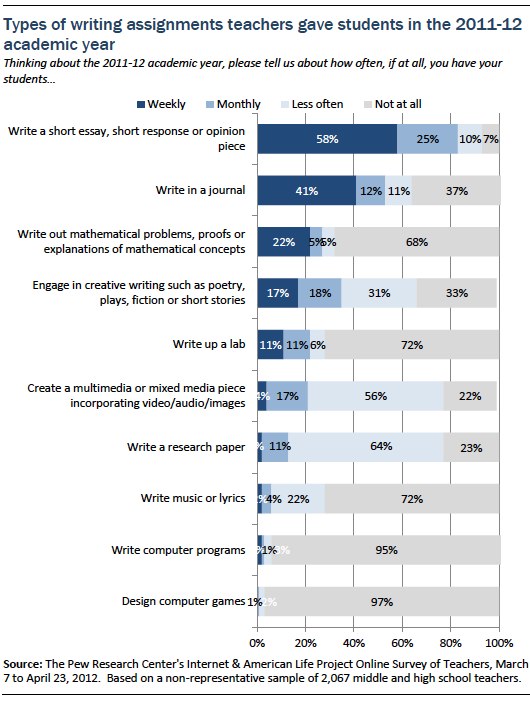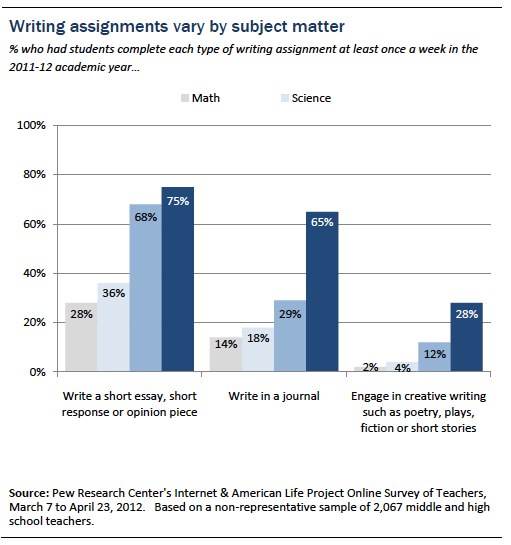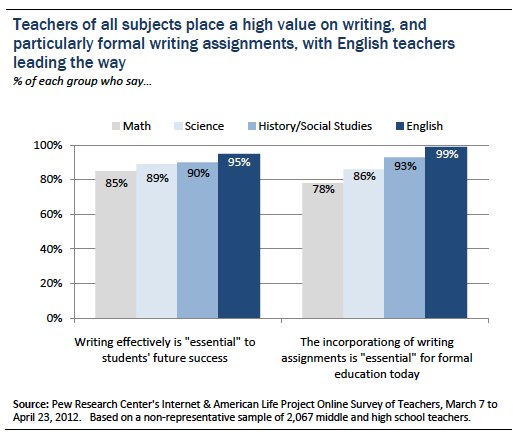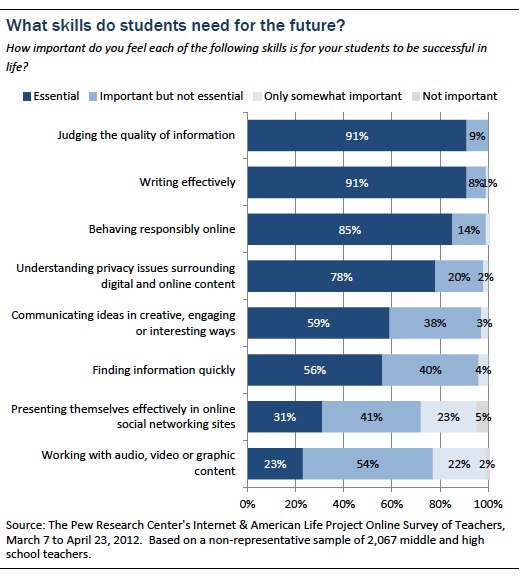AP and NWP teachers participating in the survey report giving students written assignments ranging from research papers to short responses, journaling, and creative writing. The type and frequency of written assignments varies considerably by the subject being taught and grade level, but on the whole these AP and NWP teachers place tremendous value on formal written assignments.
These teachers also point out that “writing” can be defined more broadly than written work assigned in an academic setting. In focus groups, many teachers noted that in addition to the “formal” writing students do for class, they are engaged in many forms of writing outside of the classroom, much of it using digital tools and platforms such as texting and online social networking. How to define these new types of writing and determining what impact they have on the “formal writing” students do in class remains an open question for many of these teachers. But most agree that among students, “writing” continues to be defined as assignments they are required to do for school, as opposed to textual expression they engage in on their own time.
The writing assignments AP and NWP teachers give their students
The survey quantified what types of writing exercises AP and NWP teachers assign to their middle and high school students. As the graphic below suggests, among this group of teachers, short essays and journaling are the most commonly assigned writing tasks. More than half of the sample (58%) report having their students write short essays, short responses, or opinion pieces at least once a week. Four in ten (41%) have students journal on a weekly basis.
Research papers, multimedia assignments, and creative writing in the form of plays or short stories, while not assigned by many teachers on a weekly basis, are assigned at some point during the academic year by most of these AP and NWP teachers. Just over three-quarters report having students complete a research paper (77%) or a multimedia project (77%) at some point during the current academic year. Two-thirds (66%) have students engage in creative writing, such as poetry, a play, a short story or piece of fiction, at least once a year.
In contrast, more specialized types of writing assignments such as writing out mathematical problems or proofs, writing up labs, writing computer programs, designing computer games, and writing music or lyrics are assigned rarely, if ever, by most AP and NWP teachers surveyed.

The type and frequency of written work assigned is obviously highly dependent on the subject matter being taught. Among Math teachers, for example, 81% report having students write out mathematical problems, proofs or concepts on at least a weekly basis. And among science teachers, 51% have students write up labs at least once a week and 56% have students write out mathematical concepts or problems. All of these percentages are much higher than those for teachers of other subjects.
In addition, while 94% of English teachers and 83% of history/social studies teachers had their students write a research paper in the 2011-2012 academic year, that figure is 68% among science teachers and 36% among math teachers. A similar pattern emerges for multimedia or mixed media assignments, with English (84%) and history/social studies (82%) teachers most likely and math teachers least likely (51%) to have given their students this type of assignment in the prior academic year. Science teachers (70%) fall in the middle.

How do teachers—and students—define “writing” in the digital world?
A fundamental question posed to the AP and NWP teachers in the current study is how they and their students define “writing.” Specifically, we asked teachers which forms of writing in the digital age—academic writing assignments, texting, social network site posts, blogs, tweets, etc.— are “writing” in their eyes, and which are not? In a 2008 Pew Internet survey of teens on this topic, the consensus among 12-17 year-olds was that there is a fundamental distinction between their digital communications with friends and family and the more formal writing they do for school or for their own purposes. Only the latter is considered “writing” in teens’ eyes.9 Survey and focus group findings in the current study indicate this perception has not changed, either among students or their teachers, and that there remains a fairly strong conceptual divide between “formal” and “informal” writing. For both groups, much day-to-day digital communication falls into the latter category.
Asked in focus groups to clarify what, specifically, they consider “writing,” the majority of teachers indicated that “formal writing” and “creative writing” fit their definition of “writing.” Slightly fewer said they would classify “blogging” as writing, and very few said they would consider texting as a form of writing. Asked how they thought students would categorize these same writing forms, the results are comparable. Most of these teachers do not think their students consider texting writing, but rather confine their definition of “writing” to those exercises they are required to do for school. A handful of teachers went even further, saying that some students define “writing” only as something that requires them to use complete sentences.
On how students define “writing,” AP and NWP teachers say…
[students]
Our kids, over the course of their lives, will write infinitely more than we ever will. I’m 43 years old–half of my life was lived without email, texting, social networking, etc. The fact is, that is writing. Kids have more access points today and those access points are literally at our fingertips and beeping and buzzing blipping…nudging us to write. Incredibly though, students do not see this as “writing.”
Because students still write journals in some classes, I think they still distinguish this from blogging. I think they see journaling as writing, but not blogging quite yet. Although, I think that is starting to change as they start blogging for classes. I think blogging will be viewed as more official writing in the future.
While most AP and NWP teachers in the focus groups said they do not consider texting, blogging, or micro-blogging (posting on social network sites) “writing” in the traditional sense, they believe these digital formats do spur thinking and encourage communication among their students, which may lead to deeper thinking and self-expression. Several teachers characterized these shorter online posts as “pre-writing” that may get a student engaged in a topic or discourse enough to want to write a longer piece about it or explore it further. In some teachers’ eyes, these digital forms of expression are building blocks for lengthier, more formal writing.
On newer digital forms of writing, AP and NWP teachers say…
These digital technologies give students a reason to write. Social media and texting are very engaging for them; they write reflexively. It is not classic academic writing for sure. But, they do use the written language to communicate. This requires a certain amount of composition activity. Texters must decide the most efficient set of words to include in their message in order to convey meaning. These activities are “pre-academic writing”, but nevertheless for some kids they are formative processes that can lead to more sophisticated composition skills.
Students can write and voice ideas in many different registers. It is often not “academic” writing in the sense that many teachers would consider. However, I think the kinds of real world applicability of student work in classes makes these new digital tools much more relevant for students beyond their schooling years.
I read a fascinating article that talked about the impact of micro-blogging on writing. The piece started talking about how everyone just assumed that when things like Twitter and Facebook began to become more prevalent we would see a decline in our society’s willingness to take the time to write. What the article went on to explain however, was that many people who blurt something out on these sites are also actually taking the time to digest what others are saying on the matter, collaborate or chat with the others who are talking about the same thing, and then in turn they feel more compelled to go on and take the time to compose a longer piece of writing – such as a blog post. I see a lot of truth to this idea. In essence, the micro-blog has become to some their pre-writing.
Teachers in the study say today’s students are expressing themselves more, and more often
Though most AP and NWP teachers who participated in the study do not characterize activities such as texting, tweeting, blogging or micro-blogging on social network sites as “writing” in the strictest sense, there is almost universal agreement among them that the digital ecology in which today’s teens live provides many more avenues for personal expression. In addition, most agree that many forms of personal expression are more accessible to the average student than has been the case for past generations. Ultimately, most of these teachers see their students expressing themselves in text (and other formats) more so than was the case when they themselves were in middle and high school. Asked in focus groups, if students today simply write more, in sheer quantity, most participating AP and NWP teachers agree this is the case.
On whether today’s students write more than prior generations, AP and NWP teachers say…
Digital technologies provide many opportunities to practice writing through participation. Mobile technologies allow one to write, capture, edit, & publish while on the go, anytime, anywhere. Be it at a museum, walk through the old neighborhood, or on a wilderness hike. Writing is no longer limited to a designated time or location.
They enjoy writing. When you talk to these kids, they like to write. They don’t like to write when you tell them, ‘I want you to write this.’ But in fact they love to write, and when you look at what they’re writing, they’re talking about themselves and expressing themselves. Maybe not well but they are speaking their minds, so they are, I think, exploring who they are and what they’re about and they’re reading what other people are writing and looking at, and exploring other people’s feelings and ideas.
The informality of the written word and how students use the language is the downside of technology, but the upside is that students are communicating in the written form much more than I ever did at their age.
The ease of accessibility brought via technology has opened the availability of writing opportunities for students today. Some devices have tempted students to write everything as if it were a text, but teacher focus on this issue can channel the text craze into more academic writing. I think like all technologies, there are good and bad points, but at least the thought processes of writing are taking place.
I think they’re writing more, more than ever, and I think they have a much more positive outlook on writing, not just because of the school…you have Facebook, you have email, you have Twitter…they’re writing constantly.
[other teacher]
92% of AP and NWP teachers surveyed describe writing assignments as “essential” to the formal learning process, and “writing effectively” tops their list of skills students need to be successful in life
The survey gauged AP and NWP teachers’ sense of the overall importance of incorporating writing into formal learning today, and asked them to rank the value of effective writing vis a vis other skills students may need to be successful in life. The vast majority (92%) say the incorporation of writing assignments in formal learning is “essential,” with another 7% saying it is “important, but not essential.” Only 11 teachers out of more than 2,000 describe the incorporation of writing assignments into formal learning as “only somewhat important” or “not important.”
These results are not surprising, given the large number of writing teachers in the sample and the focus on formal writing in much of the U.S. educational system. But the high value placed on writing extends across AP and NWP teachers of all subjects. While 99% of English teachers in the sample say that writing assignments are essential to the formal learning process, the same is true for 93% of history/social studies teachers, 86% of science teachers, and 78% of math teachers.
Asked to place a value on various skills today’s students may need in the future, “writing effectively” tops the list of essential skills, along with “judging the quality of information.”10 Each of these skills is described as “essential” by 91% of AP and NWP teachers surveyed. Again, while large majorities of teachers of all subjects respond this way, English teachers are slightly more likely than others to say that “writing effectively” is an “essential” skill for students’ future success.

Other skills relevant to the current digital culture also rank high as life skills, with large majorities of these teachers saying that “behaving responsibly online” (85%) and “understanding privacy issues surrounding online and digital content” (78%) are “essential” to students’ success later in life. Skills that fewer of these AP and NWP teachers view as essential for students’ success in life include “presenting themselves effectively in online social networking sites” and “working with audio, video, or graphic content.” Fewer than one in three AP and NWP teachers in the sample describes either of these skills as “essential” to their students’ futures, though pluralities do describe each of these skills “important, but not essential.”

Do AP and NWP teachers see continued value in longer writing assignments?
The tremendous value most AP and NWP teachers place on writing of all forms, and particularly “formal” writing, was reflected throughout focus group discussions. For some AP and NWP teachers, the extent to which today’s middle and high school students engage in what many see as “informal” writing means that “formal” writing assignments are more critical than ever. Moreover, many see tremendous value in longer writing assignments that require students to organize their thoughts and fully develop complex ideas (particularly because they often have to present ideas on standardized tests in this format). They see longer, formal writing assignments as an important juxtaposition to the more informal and often more truncated styles of expression in which their students regularly engage. Throughout focus groups, AP and NWP teachers expressed the belief that students must master all styles of writing in order to be successful across social domains and to communicate with different audiences.
On the value of longer writing assignments in the digital world, AP and NWP teachers say…
There is great purpose and value in teaching students to write long and formal texts. Again, there are a whole lot of ideas that simply cannot be reduced simply without serious distortion or reduction. Consequently, developing complex ideas and thinking often requires longer texts. Writing is a demonstration of thinking, after all. So the deeper and more complex the thinking, the more that is reflected in the writing. As for formal texts, academia certainly requires a greater level of formality but so does a lot of work in the political, legal, and commercial world. Formal writing is almost always a factor that can be used for exclusion. Inability to write formal texts potentially robs students of voice and power. Arguably more important is the ability to recognize and adjust to the context that is appropriate for a given purpose. So knowing when and how to write with greater formality is an essential skill.
The organization and critical thinking skills that must be employed when students write a longer, more formal piece are skills that will students to become better, more engaged citizens. The processes of brainstorming, researching, evaluating, selecting, analyzing, synthesizing, revising are all skills that help students become more critical citizens, more discerning consumers, and better problem-solvers.
To carry an idea out to see if it is “true” to the thinker or not, I think this is so important. I want students to grapple with the complexity of a subject, to see it from all sides by way of a formal written response. Further, I think breaking down that response into its finer parts help me to teach the components that would go into an extended response. An example of this would be a section of their packet simply titled, DEFINITION. Before going into their response, I ask my students to define their terms and to set their parameters for the paper, not only as a service to their readers, but as a guidepost for themselves.
Writing is thinking—and, quite honestly, I don’t think any of us fully knows what our writing is (will be) about until we write it. Writing develops our thoughts and allows us to grapple with the “whats” and the “whys” of life. In this respect, writing informal and formal texts serves as role playing exercises as much as they do anything else. It is practice in being critical, analytical, reflective, informative and so on. We’re shipping young people out into the world where they are going to have to buy a car, a lawn mower, a stove…and they are going to want to read informative reviews before they spend their money. Writing it allows us to become familiar with it–we may never write an informative review once we leave school, but some…many…will want to read reviews before they spend their own money on something. Beyond buying something, I want to emphasize “writing is thinking is role play for life” as a cross-curricular ideal that too often becomes buried as just an English class objective.
Long texts give students the opportunity to deeply analyze an idea. Longer texts are essential to articulate complex concepts and beliefs. Although not everyone will be asked to write a long academic paper for their jobs, the reflection that goes behind this type of writing is critical for everyone. The process of making thinking transparent and clear to others is essential to knowing the why behind the what. The notion of form al texts supports the idea of knowing how to communicate with various audiences. The more registers a person has in his or her arsenal, the more effective that person will be when communicating with a diverse group.
I think that there is value of having long and well organized thoughts about a topic. I think that when we delve deeply into a topic and have to provide an argument or exploration then we must be able to write logically and coherently and be able to develop a point without getting off track. We must be able to write for an audience and provide evidence and delve deeply. I think there are also audience needs to be met when deciding on what level of formality we will write with so I see the value in teaching formal writing. People have to produce reports for colleagues and prospective business partners and college professors so this is obviously a skill that needs to be learned.
Writing is crucial across the curriculum. Good writing teachers teach students how to communicate a logical argument that is well-researched. At my school, I am impressed with the amount our English and history students write as well as the amount our science students write. The IB program does not have many multiple choice tests; therefore, students have to be good writers to perform well on IB exams… The IB program places such a heavy emphasis on communication that the students (and teachers) have adapted their definition to include anything that involves clearly stating ideas and explaining rationale.
While many focus group participants stressed the importance of learning to write in multiple styles—including more “formal” styles—and to write lengthier pieces on complex topics, other teachers questioned the “term paper mentality” and the tendency of some educators to equate length of assignment with complexity of thought. Some AP and NWP teachers in the study debated the value of longer textual expression today, not just for students but for society as a whole. As many digital tools encourage shorter, more concise expression, these teachers questioned whether mastering more traditional writing styles will be critical for their students moving forward. While these skills may be valued in standardized testing and in the college and university settings, there was some debate about how useful these skills are beyond those two arenas. Moreover, some teachers questioned whether lengthy writing assignments are the most effective format for teaching students specific writing skills.
On the value of longer writing assignments in the digital world, AP and NWP teachers say…
[teachers]
Regardless of the length of a student’s writing, I think it is more important to teach students to develop their thoughts completely. If development of thought can come through length or formality then so be it. More important than length or formality would be for students to have a firm understanding about how to organize their ideas in such a way where they can effectively communicate their thoughts and ideas. I certainly don’t think that a teacher should only teach any one kind or length of writing, but the most often I hear the reason we should teach students to write lengthy formal essays is because that is the way they will have to write in high school, which in turn is how they will have to write in college. While I would say there can be value in getting a student dedicated to deeply investigating a certain topic through a longer writing assignment, I would never be willing to teach kids formal writing just because that is the way they do it in high school – there would have to be another purpose.
This almost starts to get at the “how many words should this be question.” I tend to find that when I say 500 words long, kids work to that end and stop. Sometimes they seem to like this better…it’s easy and sure. Usually, I say to make a plan and work to thoughtful response to the assignment and the feedback from their peers. This usually drives more from their thought process that my giving them a word count. Is this a formal text? Not really, but yes at the same time. I think many teachers panic when students deviate from the 5 paragraph essay that they know and understand. The belief seems to be that this serves their needs on the near future high stakes test that are demanded on students. I’m not sure that this serves them past this point.
I don’t think length is a point to pound home with any student. We need to look at the content of a students’ writing the most. If that means a paper has 8-10 pages to it, then so be it, but students need to learn how to sort out what is relevant and irrelevant details and information. Students need to produce well planned, thought out papers that get to the point.




